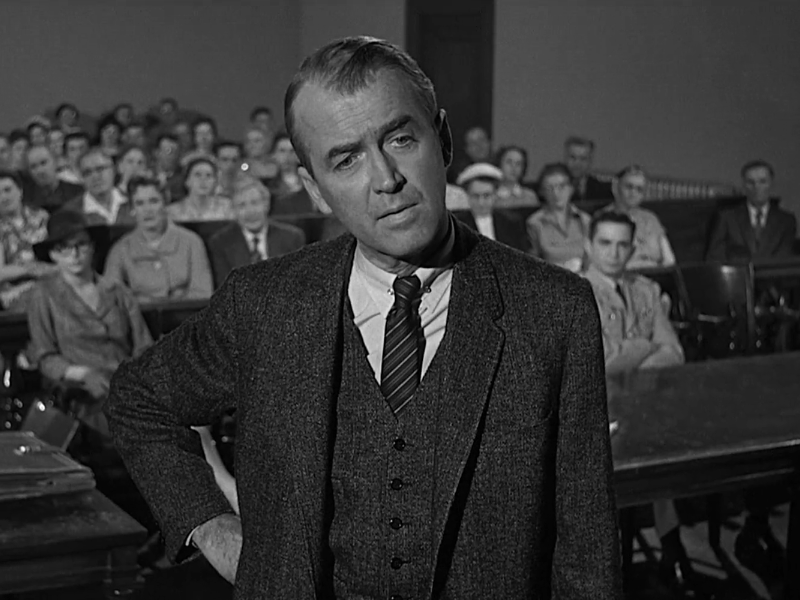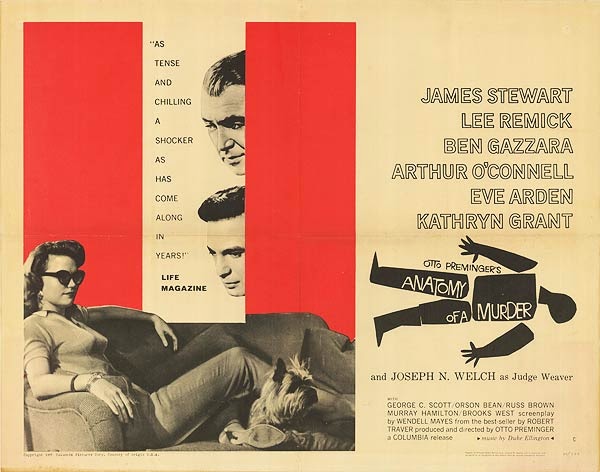
A small-town Michigan lawyer takes on the difficult task of defending a young army lieutenant named Frederick Manion, arrested for the murder of a local bartender who he claims raped his wife. After Manion pleads non-guilty however, a detailed journey to discover the truth unfolds to the rhythm of Duke Ellington’s sumptuous score.
“Preminger sets Stewart’s easy humour, graceful movements and controlled rage against the very different mannerisms of Ben Gazzara (as a soldier who has committed a crime of passion) and George C. Scott (as a fancy city lawyer). If directing is the art of placing bodies in a space before the camera, then Preminger was a great director. He liked large, open frames that allowed maximum latitude for elaborate movements of both actors and camera. In the courtroom sequences that are the highlight of Anatomy of a Murder, film, this style beautifully expresses Preminger's favourite themes: public life as a theatre of lies, bluffs and masquerades; the lethal ambiguity of human actions; and the fascinating inscrutability of what drives the heart and mind.”
Adrian Martin1
“The duel between Biegler and Dancer can be read as the tangling of two directors with rival visions of the material, quibbling to revise the words entered into the record to convey their preferred versions: opinion rather than fact; evening walks rather than prowls; Biegler’s fine differentiation between woman chaser, masher, and wolf. We want to see Biegler’s draft go over–but why? Of course, we feel a natural camaraderie after spending the film sequestered with him and his team. There is also Dancer’s off-putting cross-examination of Mrs. Manion, almost a bullying pickup, with Scott jutting his chin into the witness stand, losing his eyes in her hair–‘Do you always wear panties, Mrs. Manion?’–all to depict the witness as a wanton woman, a ‘huntress.’ But no more than Biegler or Dancer does the viewer have any certitude as to what the actual facts onto which they’re imposing their stories are. Per Leon Ames’s lawyer in Angel Face: “The truth is what the jury decides.” Any truth beyond that never outs, any more than the broken body in Saul Bass’s title design comes together again. Whereas the elusiveness of objective reality is the point of Akira Kurosawa’s Rashomon (1950), Preminger’s film assumes that ambiguity, then shows how the system processes it. That process, rather than any outcome, is Anatomy of a Murder’s subject. The verdict illustrates the legal system at work, though the question of whether a ‘just result’ has been achieved is only further occluded as information accumulates. The movie is full of dead ends, turnoffs that Biegler takes that fail to lead him out of the limbo of his own reasonable doubt. It’s finally uncertain what actually happened to Laura Manion, and if it was entirely without her consent–before answering in the negative Biegler’s question ‘Does [your husband] have any reason to be jealous?’ she retreats behind inscrutable shades. Biegler puts the film’s theme of unknowability to the prosecution’s own psychiatrist rather well: ‘Psychiatry is an effort to probe into the dark, undiscovered world of the mind–and in there, the world could be round, it could be square.’
Nick Pinkerton2

- 1Adrian Martin, “Anatomy of a Murder,” Film Critic: Adrian Martin, September 1994.
- 2Nick Pinkerton, “Anatomy of a Murder: Atomization of a Murder,” Criterion, 22 February 2012.

